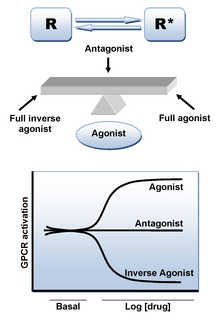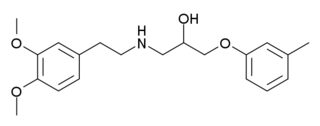
Beta blockers are a class of medications that are predominantly used to manage abnormal heart rhythms, and to protect the heart from a second heart attack after a first heart attack. They are also widely used to treat high blood pressure (hypertension), although they are no longer the first choice for initial treatment of most patients.

Propranolol, sold under the brand name Inderal among others, is a medication of the beta blocker class. It is used to treat high blood pressure, a number of types of irregular heart rate, thyrotoxicosis, capillary hemangiomas, performance anxiety, and essential tremors. It is used to prevent migraine headaches, and to prevent further heart problems in those with angina or previous heart attacks. It can be taken by mouth or by injection into a vein. The formulation that is taken by mouth comes in short-acting and long-acting versions. Propranolol appears in the blood after 30 minutes and has a maximum effect between 60 and 90 minutes when taken by mouth.

Diltiazem, sold under the brand name Cardizem among others, is a calcium channel blocker medication used to treat high blood pressure, angina, and certain heart arrhythmias. It may also be used in hyperthyroidism if beta blockers cannot be used. It is taken by mouth or injection into a vein. When given by injection, effects typically begin within a few minutes and last a few hours.

Isosorbide mononitrate, sold under many brand names, is a medication used for heart-related chest pain (angina), heart failure, and esophageal spasms. It can be used both to treat and to prevent heart-related chest pain; however, it is generally less preferred than beta blockers or calcium channel blockers. It is taken by mouth.

In pharmacology, an inverse agonist is a drug that binds to the same receptor as an agonist but induces a pharmacological response opposite to that of the agonist.

Labetalol is a medication used to treat high blood pressure and in long term management of angina. This includes essential hypertension, hypertensive emergencies, and hypertension of pregnancy. In essential hypertension it is generally less preferred than a number of other blood pressure medications. It can be given by mouth or by injection into a vein.

Bisoprolol, marketed under the tradename Zebeta among others, is a beta blocker medication most commonly used for heart diseases. This specifically includes high blood pressure, chest pain from not enough blood flow to the heart, and heart failure. It is taken by mouth.

Carvedilol, sold under the brand name Coreg among others, is a medication used to treat high blood pressure, congestive heart failure (CHF), and left ventricular dysfunction in people who are otherwise stable. For high blood pressure, it is generally a second-line treatment. It is taken by mouth.

An adrenergic antagonist is a drug that inhibits the function of adrenergic receptors. There are five adrenergic receptors, which are divided into two groups. The first group of receptors are the beta (β) adrenergic receptors. There are β1, β2, and β3 receptors. The second group contains the alpha (α) adrenoreceptors. There are only α1 and α2 receptors. Adrenergic receptors are located near the heart, kidneys, lungs, and gastrointestinal tract. There are also α-adreno receptors that are located on vascular smooth muscle.
A sympatholytic drug is a medication that opposes the downstream effects of postganglionic nerve firing in effector organs innervated by the sympathetic nervous system (SNS). They are indicated for various functions; for example, they may be used as antihypertensives. They are also used to treat anxiety, such as generalized anxiety disorder, panic disorder and PTSD.

Cyanopindolol is a drug related to pindolol which acts as both a β1 adrenoceptor antagonist and a 5-HT1A receptor antagonist. Its radiolabelled derivative iodocyanopindolol has been widely used in mapping the distribution of beta adrenoreceptors in the body.

Iodocyanopindolol (INN) is a drug related to pindolol which acts as both a β1 adrenoreceptor antagonist and a 5-HT1A receptor antagonist. Its 125I radiolabelled derivative has been widely used in mapping the distribution of beta adrenoreceptors in the body.

Bevantolol (INN) was a drug candidate for angina and hypertension that acted as both a beta blocker and a calcium channel blocker. It was discovered and developed by Warner-Lambert but in January 1989 the company announced that it had withdrawn the New Drug Application; the company's chairman said: "Who needs the 30th beta blocker?" As of 2016 it wasn't marketed in the US, UK, or Europe and the authors of a Cochrane review could find no product monograph for it.

ZK-93426 (ethyl-5-isopropoxy-4-methyl-beta-carboline-3-carboxylate) is a drug from the beta-carboline family. It acts as a weak partial inverse agonist of benzodiazepine receptors, meaning that it causes the opposite effects to the benzodiazepine class of drugs and has anxiogenic properties, although unlike most benzodiazepine antagonists it is not a convulsant and actually has weak anticonvulsant effects. In human tests it produced alertness, restlessness and feelings of apprehension, and reversed the effect of the benzodiazepine lormetazepam. It was also shown to produce nootropic effects and increased release of acetylcholine.

Isamoltane (CGP-361A) is a drug used in scientific research. It acts as an antagonist at the β-adrenergic, 5-HT1A, and 5-HT1B receptors. It has about five times the potency for the 5-HT1B receptor over the 5-HT1A receptor. It has anxiolytic effects in rodents.

Bufuralol is a potent beta-adrenoceptor antagonist with partial agonist activity. It is metabolized by CYP2D6.

Nifenalol is a beta-adrenoceptor antagonist.

Ridazolol is a pharmaceutical drug acting as a beta adrenergic receptor antagonist. It was investigated in the 1980 and 90s for its effects on coronary heart disease and essential hypertension.
Beclometasone/formoterol/glycopyrronium, sold under the brand name Trimbow among others, is an inhalable fixed-dose combination medication for the treatment of chronic obstructive pulmonary disease (COPD). It contains beclometasone dipropionate, formoterol fumarate dihydrate, and glycopyrronium bromide.

Vibegron, sold under the brand name Gemtesa, is a medication for the treatment of overactive bladder.


















